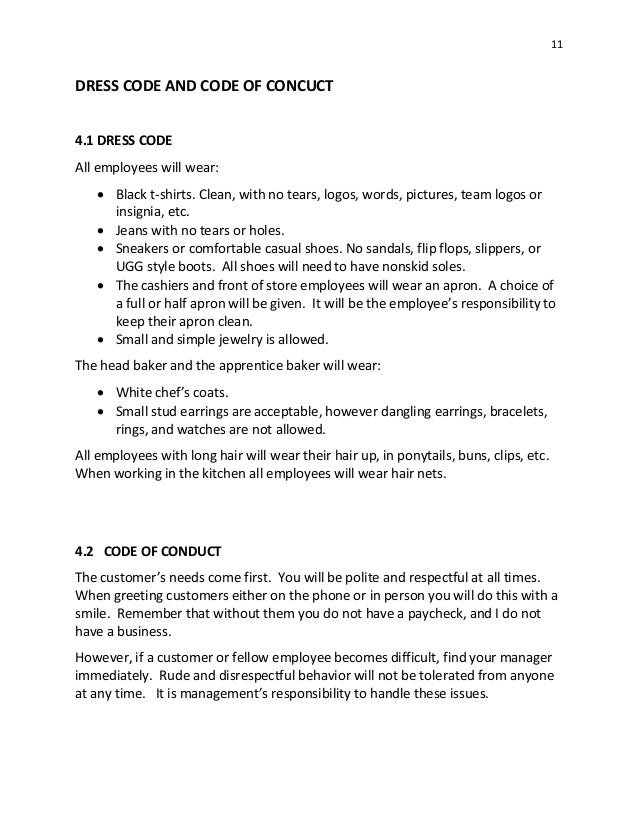06 Jan Bakery Operation Safety
Budget for Bakery Manual I will donate my time to create and prepare the manual with no labor cost and by doing so your total cost for the manual will be approximately $197.09 for supplies and materials. The total cost includes the price of printing and binding the manual.
- Employees may only admit non-employees to work areas with management approval or as part of a Company-sponsored program. These visits should not disrupt workflow. That’s The Cake Bakery’s employee must accompany the non-employee at all times. Former employees are not permitted onto Company property except for official Company business.
- Sugar Shoes Bakery Manual 12.2014 1. Sugar Shoes Bakery EMPLOYEE HANDBOOK Prepared By: Kathleen Haupt, Owner and Proprietor 12/2014 NOTE: The content of this manual does not constitute nor should it be construed as a promise of employment or as a contract between Sugar Shoes Bakery and any of its employees.
- This manual will introduce you to the different appliances you will use as an employee in the Costco Bakery, as well as provide you with the information required to properly operate and clean each machine.


Employee Manual For A Bakery Job

The bakery business can be an enjoyable and rewarding profession, but some bakery processes can also be hazardous. Persons who work in bakery operations should be instructed in how to avoid or prevent potential hazards and be properly trained to follow recommended safe work practices.
Slips and falls are common bakery accidents due to wet floors, spilled dough, batter, and dry ingredients, as well as uneven or obstructed floor surfaces. Stack materials neatly to keep walkways and production areas clear. Immediately clean up spills and post warning signs when floors are wet or slippery. Use a degreasing solution on oil and grease spills. Gets safety training on use of ladders and stepstools. Slip-resistant floor coverings and shoe soles prevent slips and falls.
Employee Manual For Bakery
Bakery equipment such as moving blades, mixing arms, and conveyors on dough brakes, pie and tart machines, mixers, rollers and dividers pose cutting and caught/crush hazards. Maintain equipment in good condition. Guard moving and sharp parts. Keep equipment clearances to avoid accidentally bumping into moving parts. Use safety devices such as power interlocks, two-handed controls, and emergency-stop bars. Practice lockout/tagout during maintenance and cleaning. Place warning signs on equipment with moving equipment dangers.
Gas and electric heat sources in bakeries pose a fire risk. Know and drill your fire evacuation plan. Keep escape routes clear of storage and debris. Keep fire extinguishers handy; both the ABC Class for general fires and the K Class for kitchen fires. Turn off and unplug electrical appliances when not in use. High temperature cut-off switches prevent equipment overheating. Control grease and oil buildup from donut machines, grills, and fryers with ventilation hoods and fire extinguishing systems.

Boiling water, hot oil, and hot ingredients (syrups, milk) can scald bakery workers. Hot surfaces on warming trays and lights, grills, ovens, cooking pans and trays can burn you. Use heat-resistant gloves or mitts for handling hot trays and pots. Don’t carry hot liquids around the work area and avoid splashes when pouring them. Label and guard hot water pipes and vessels. Know first aid for minor burns: cool the area under running water and wrap loosely in sterile dressing. For major burns, call 911. Maintain a first aid kit.
Breathing flour dust can cause asthma and nose, throat, and eye irritation. Repeated exposure to flour and dough can sensitize skin. Control flour dust with enclosed storage bins, adequate ventilation, and enclosed mixing. Don’t sweep flour from floors; use a high-efficiency vacuum cleaner or wet mopping. Clean work surfaces throughout the day to prevent dough and flour buildup. Use a nuisance dust mask if flour dust cannot be controlled. Gloves and long sleeves protect your hands and arms from dough and flour exposure.
Employee Manual For A Bakery Cake Designs
Handling heavy ingredients, food trays, mixing bowls, and cooking vessels can result in back and muscle injuries. Use good lifting techniques or mechanical aids (carts, lifts) when moving heavy objects. Get training on forklifts and mechanical lifts. Secure each load because materials and bowls can cause severe injuries if they fall during transport. Organize your work area and storage to limit reaches. Adjust work surfaces or use stable platforms to get a comfortable working height.